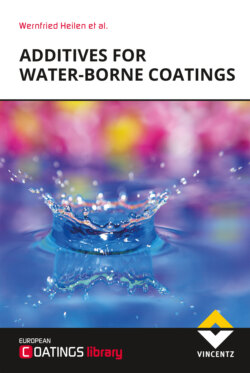Читать книгу Additives for Water-borne Coatings - Wernfried Heilen - Страница 12
На сайте Литреса книга снята с продажи.
2.1.3.2Steric stabilisation
ОглавлениеIn aqueous environments, steric stabilisation is another mechanism which frequently occurs. The adsorbed additive molecules form a polymeric shell around the pigment particle. This polymeric shell consists of the anchoring groups of the additives and a diffuse layer of polymeric chains. To achieve optimal stabilisation, the polymeric chains must be completely soluble in the surrounding water/binder mixture. They form an outer shell around the pigment particle. As particles come closer, the polymeric shells start to overlap, leading to steric hindrance. A simple model would be two wooden balls that carry wire springs. If the balls approach each other, the springs prevent contact between the wooden surfaces. In thermodynamic terms, the degree of freedom of movement of the polymeric chains is reduced when the chains overlap, leading to a reduction in entropy. To compensate for this reduction and to reinstate the mobility, the separation of the pigment particles must increase.
The change in free energy is given by
ΔG = ΔH – TΔS
where
| ΔH: | change of enthalpy |
| ΔS: | change of entropy |
| T: | absolute temperature |
Important factors influencing the efficiency of stabilisation are the degree of adsorption of the polymers on the surface, the integrity of the polymeric shell and its thickness. The thickness of the polymeric shell and the degree of stabilisation are increased if the additive chains interact with binder molecules (Figure 2.2b) [3].
Figure 2.2b: Steric stabilisation
